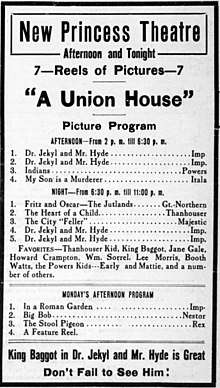Dr. Jekyll and Mr. Hyde (1913 film)
Dr. Jekyll and Mr. Hyde is a 1913 horror film based on Robert Louis Stevenson's 1886 gothic novella The Strange Case of Dr. Jekyll and Mr. Hyde. Directed by Herbert Brenon for producer Carl Laemmle's company IMP (which he later changed to Universal Pictures), the production stars King Baggot in the dual role of Jekyll and Hyde. The film was re-released in the United States in August 1927.[2][3]
| Dr. Jekyll and Mr. Hyde | |
|---|---|
 Texas newspaper schedule of local theatre's films, including Dr. Jekyll and Mr. Hyde | |
| Directed by | Herbert Brenon |
| Produced by | Carl Laemmle[1] |
| Screenplay by | Herbert Brenon |
| Based on | The Strange Case of Dr Jekyll and Mr Hyde by Robert Louis Stevenson |
| Starring | King Baggot Jane Gail Matt B. Snyder Howard Crampton |
Production company | IMP Independent Moving Pictures Co. of America |
| Distributed by | The Universal Film Manufacturing Company, Incorporated |
Release date | 1913 |
Running time | Two reels (26 minutes) |
| Country | United States[1] |
Plot
Dr. Henry Jekyll (King Baggot) sends a note to his fiancée, Alice (Jane Gail), and her father (Matt B. Snyder) to say that instead of accompanying them to the opera, he must give more time to his charity patients. At Jekyll’s practice, his friends Dr. Lanyon (Howard Crampton) and Utterson (William Sorrel), a lawyer, ridicule him for what they consider his dangerous research. Alice and her father also visit Jekyll’s rooms, but although apologetic, the doctor insists on devoting his time to his patients. That night, however, Jekyll undertakes a dangerous experiment, swallowing a drug intended to releases his evil self. His body convulses, and he transforms into a hunched, twisted figure.
The strange creature emerges from Jekyll’s room, bearing a note in Jekyll’s handwriting that orders the household staff to treat the stranger – “Mr Hyde” – as himself. Hyde then slips out into the night, terrorizing the patrons of a nearby tavern before finding himself lodgings. From these rooms, he begins a career of evil, until one night he attacks and injures a crippled child. Outraged witnesses corner Hyde and force him to agree to compensate the boy. Hyde reluctantly leads one man back to Jekyll’s house and gives him money. During this passage of events, a worried Dr. Utterson sees Hyde entering Jekyll’s house. Inside, Hyde takes a potion that transforms him back to Jekyll. The doctor swears that he will abandon his experiments and never tempt fate again; but that night, without taking the drug, he turns spontaneously into Hyde.
Cast
- King Baggot as Dr. Henry Jekyll/Mr. Hyde
- Jane Gail as Alice, r. Jekyll's fiance
- Matt B. Snyder as Alice's father
- Howard Crampton as Dr. Lanyon
- William Sorelle as Utterson, the attorney
- Herbert Brenon [1]
Critique
Like so many other performers of this period, it was standard practice for the actors to apply their own make-up. While assuming the dual role of Jekyll and Hyde, King Baggot employed a variety of different greasepaints and a tangled mass of crepe hair. Through the use of camera dissolves, Baggot was able to achieve the transformation. Critic Troy Howarth felt that "it gave him the chance to play a difficult dual role, but his performance has not aged well....his hunched over walk comes across as forced and ridiculous...evoking comparisons with Jerry Lewis'....performance as The Nutty Professor....with his unruly hair and prominent buckteeth".[1] Baggot descended into alcoholism and died in 1948.[1]
The film used a slow dissolve effect to show the transformation, as opposed to a quick matching cut, and the critics were impressed, George Blaisdell of Moving Picture World commenting "It is through the means of the dissolving process that the transformation is made peculiarly effective...You see the change of the man of good to the man of evil right before your eyes".[4]
References
- Workman, Christopher; Howarth, Troy (2016). Tome of Terror: Horror Films of the Silent Era. Midnight Marquee Press. p. 108. ISBN 978-1936168-68-2.
- "Release dates for Dr. Jekyll and Mr. Hyde". Retrieved 3 August 2010.
- "Dr. Jekyll and Mr. Hyde". Silent Era.
- Haberman, Steve (2003). "Silent Screams". Midnight Marquee Press. p. 101. ISBN 978-1-936168-15-6
External links
- Dr. Jekyll and Mr. Hyde on IMDb
- The short film Dr. Jekyll and Mr. Hyde is available for free download at the Internet Archive